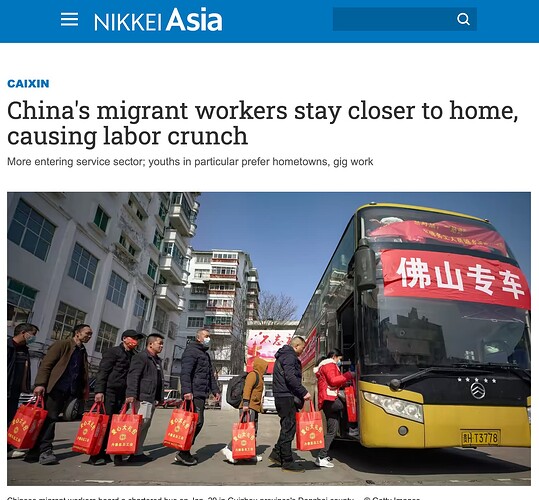-
官方数据显示,2022年中国移民在本省以外工作的人数下降了1%,进入服务行业的农村工人有所增加。
-
这一转变引发了对制造业长期劳动力短缺的担忧。
-
2022年,超过7000万移民离开家乡省份就业,而在本省就业的移民人数增加了0.9%。
-
去年,离开家乡的农村劳动力数量略有增加,但由于实行零就业政策,增长率下降了1.2个百分点。
-
中国的农村劳动力去年总体增长了1.1%,但是年轻的移民更喜欢做小工,打破了就业市场长期稳定的平衡。
-
农村劳动力在服务业的比例增加了0.8个百分点,而在制造业的比例则增加了0.3个百分点。
-
这场大流行导致了低技能工人的日益短缺,迫使公司投资于大量的自动化设备以取代手工生产。
-
这种趋势可能会导致劳动密集型工作不可逆转的下降,这可能会限制这些工人重返此类工作的机会。
-
社会保障和医疗保险等政策在各省内部得到了更好的协调,这对农村工人的吸引力越来越大。
-
Official data showed a 1% decline in Chinese migrants working outside their home provinces in 2022, with an increase in rural workers entering the service sector.
-
This shift has sparked concerns about a long-term labor shortage in the manufacturing sector.
-
More than 70 million migrants left their home provinces for employment in 2022, and the number of migrants employed in their own provinces increased by 0.9%.
-
The number of rural workers leaving their hometowns increased slightly last year, but the growth rate declined by 1.2 percentage points due to the zero-COVID policy.
-
China’s rural workforce overall grew 1.1% last year, but the preference of younger migrants to be gig workers has upset the balance in the long-term stability of the job market.
-
The proportion of rural workers in the service sector increased by 0.8 of a percentage point, while the proportion in the manufacturing sector increased by 0.3 of a percentage point.
-
The pandemic has led to a growing shortage of lower-skilled workers, forcing companies to invest in large amounts of automated equipment to replace manual production.
-
This trend could result in an irreversible decline in labor-intensive jobs, which may limit the opportunities for these workers to return to such jobs.
-
Policies such as social security and medical insurance are better coordinated within provinces, which is increasingly attractive to rural workers.
